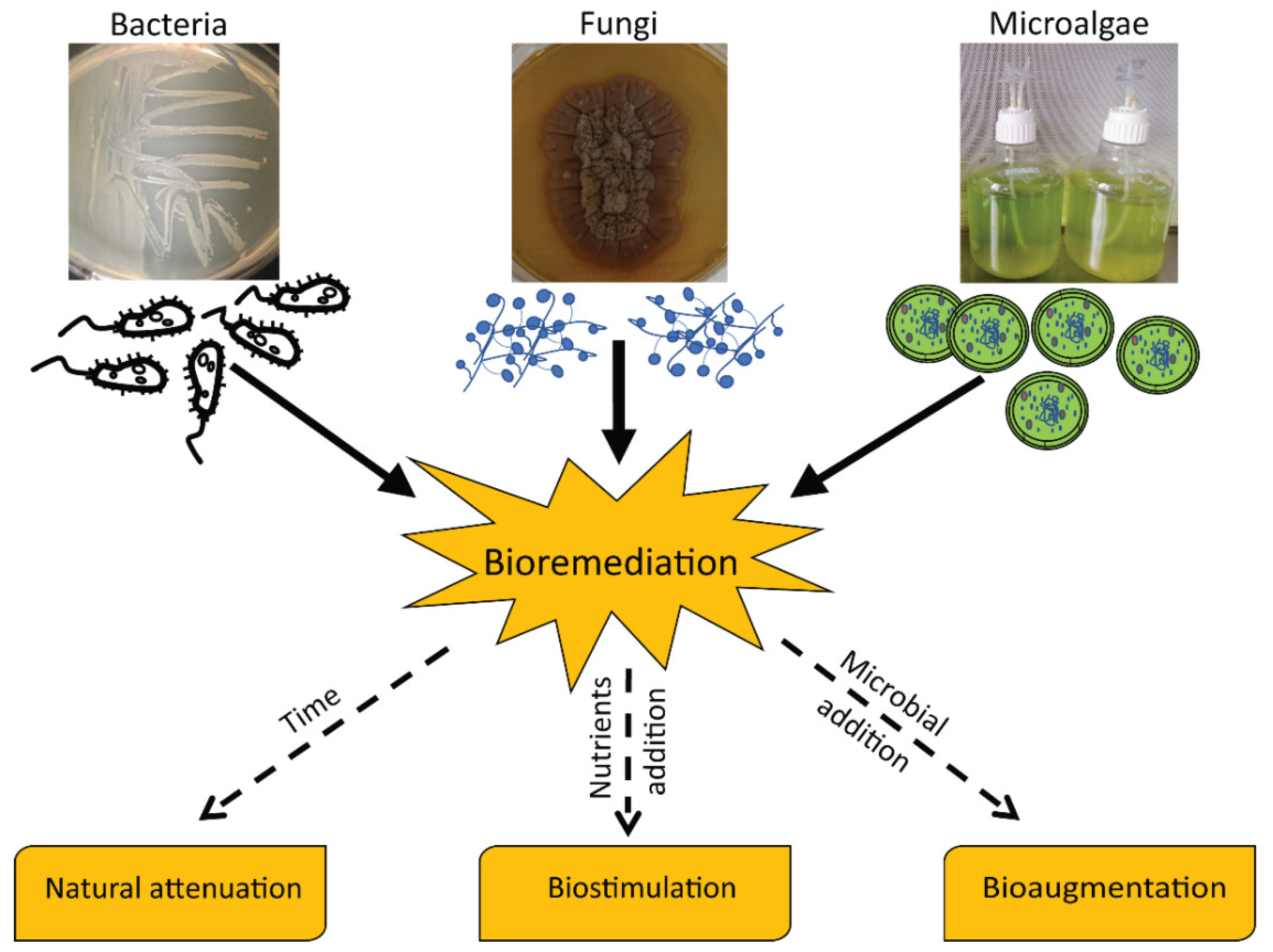5 - Some archaea are known to be resistant to variety of antibiotics including penicillin cycloheximide streptomycin etc which gives them great advantage in participating in. Autochthonous indigenous microorganisms present in polluted environments hold.

Microorganisms Free Full Text Bacteria Fungi And Microalgae For The Bioremediation Of Marine Sediments Contaminated By Petroleum Hydrocarbons In The Omics Era Html
Selection for Use as Potential Inocula for Soil Bioremediation.
. Samples recovered from the wastewater lagoon. How are microbes used in. Can we add fertilizers like phosphorus and nitrogen to make indigenous microbes grow more.
3Ananda Chakrabarty received the first US. - Extreme halophilic archaea has potential to biodegrade pollutants in hypersaline environment in which bacteria typically used in bioremediation cannot survive or function properly. 2Which is not an indigenous microbe used for bioremediation.
Mycoremediation It is the process of bioremediation in which fungus is used to clean up the contaminants. Which of the following is not an indigenous microbe used for bioremediation. Some plants take in.
Bioremediation is the use of microbes to clean up. Microbes used as a tool for bioremediation of heavy metal from the environment. The bioremediation process involving the usage of plants to degrade pollutants is a Composting b Biopile c Phytoremediation d Land farming Answer.
The present study aimed to characterize the microbial community in refinery waste and evaluate the scope for biostimulation based in situ bioremediation. Bioremediation is a process in which we use microorganisms like fungi or bacteria to convert environmental contaminants or pollutants to less toxic forms. Autochthonous indigenous microorganisms present in polluted environments hold the key to solving most of the challenges associated with biodegradation and bioremediation of polluting substances Verma and Jaiswal 2016 provided that environmental conditions are suitable for their growth and metabolism.
Bioremediation- Objective Principle Categories Types Methods Applications. Is a state-of-the-art company providing products for the application of bioremediation methods to eliminate hazardous environmental pollutants from contaminated soils and ground water. Bioaugmentation involves _____ A eliminating sludge.
For example if there is a place in which soil contains lots of ammonia NH 3 which is toxic in nature we introduce any microorganism in that soil and which convert ammonia. Microbes are very small organisms such as bacteria that live naturally in the environment. Phytoremediation It is the process of bioremediation in which plants are used for converting toxic substances to non-toxic ones.
C addition of microbes to a cleanup site. The products that we provide absorb control clean and bio-degrade contaminants in domestic and industrial locations in an environmentally responsible and safe. Nutrient deficiency severely impairs the catabolic activity of indigenous microorganisms in hydrocarbon rich environments HREs and limits the rate of intrinsic bioremediation.
Scientests are studying the genomic of organisms that are currently used or may be used for bioremediation. Isolation of Indigenous Hydrocarbon Transforming Bacteria from Oil Contaminated Soils in Libya. Bioremediation refers to the use of either naturally occurring or deliberately introduced microorganisms to consume and break down environmental pollutants in order to clean a polluted site.
Which of the following is not an indigenous microbe used for bioremediation. Adding artifical bacteria to the contaminated environment to assist indigenous microbes with biodegradation they can be genetically modified microbes intrinsic treatment when a capable microbial community nutrients and environment already exists at the site we let contaminants degrade naturally over time. On the basis of organisms used in the bioremediation process it is of the following three types-1.
Environmentally friendly and cost. Extreme halophilic archaea has potential to biodegrade pollutants in hypersaline environment in which bacteria typically used in bioremediation cannot survive or. These organisms devour dead decomposing material Griggs 2011.
This is not an indigenous microbe used for bioremediation a Pseudomonas aeruginosa b Piscirickettsia salmonis c Phanerochaete sordida d E. Coli CPhanerochaete sordida DPseudomonas aeruginosa EDeinococcus radiodurans. Which is NOT an indigenous microbe used for bioremediation.
Background Information Microbes microorganisms are single cell organisms. Numbers of researchers have shown their ability to degrade various pollutants. Anaerobic bacteria are not as frequently used as aerobic bacteria.
There is an increasing interest in anaerobic bacteria used for bioremediation of polychlorinated biphenyls PCBs in river sediments dechlorination of the solvent trichloroethylene TCE and chloroform. Patent for a GM organism. It is a process that uses mainly microorganisms but also plants or.
Full PDF Package Download Full PDF Package. B plants usage for bioremediation. Among bacteria involved in bioremediation processes most belong to the genera Alcaligens Achromobacter Acinetobacter Alteromonas Arthrobacter Burkholderia Bacillus Enterobacter Flavobacterium Pseudomonas 2223.
Most microbes used in bioremediation are bacteria Griggs 2011 although some fungi are used Scow 2011. The goal of bioremediation is the detoxification of the parent compound to a products that is no longer. Bioaugmentation seeding added bacteria to the contaminated environment to assist indigenous microbes with biodegradation.
AA transgenic mouse expressing the growth hormone gene BDolly the. Nevertheless in some instances the term biodegradation is used interchangeably with bioremediation the former is a term that applies to a process under the latter. Archaea Bioremediation The role of archaea in bioremediation has not been studied as commonly as that of bacteria.
Contaminated soil and groundwater. Bioremediation stimulates the growth of certain microbes that use contaminants as. A Pseudomonas aeruginosa b Piscirickettsia salmonis c Phanerochaete sordida d E.
View How are microbes used in the bioremediation of contaminated groundwater sitesdocx from BIOL MICROBIOLO at Carleton University.

3 Integrated Approach Of Bioremediation Including Bioaugmentation And Download Scientific Diagram

Current Status Challenges And Future Of Bioremediation Sciencedirect
3 Integrated Approach Of Bioremediation Including Bioaugmentation And Download Scientific Diagram
0 Comments